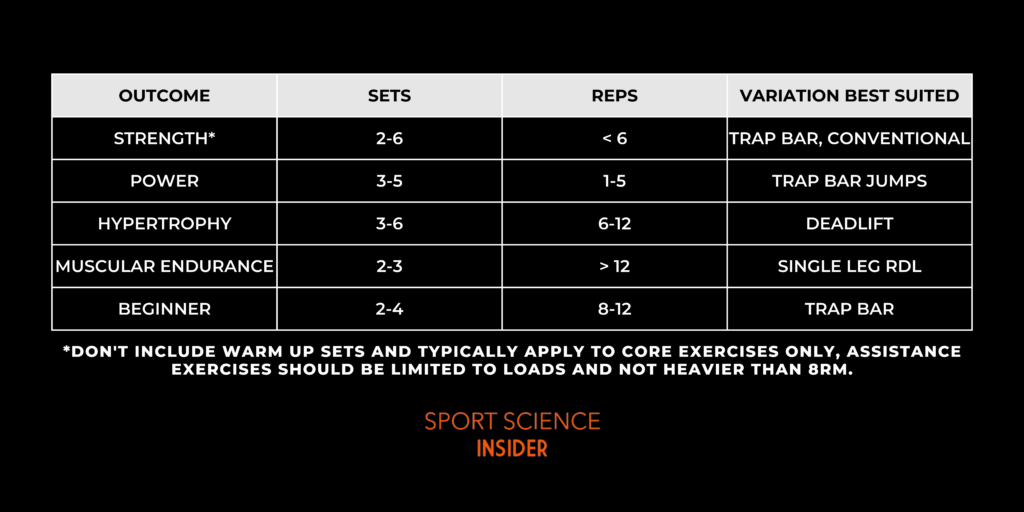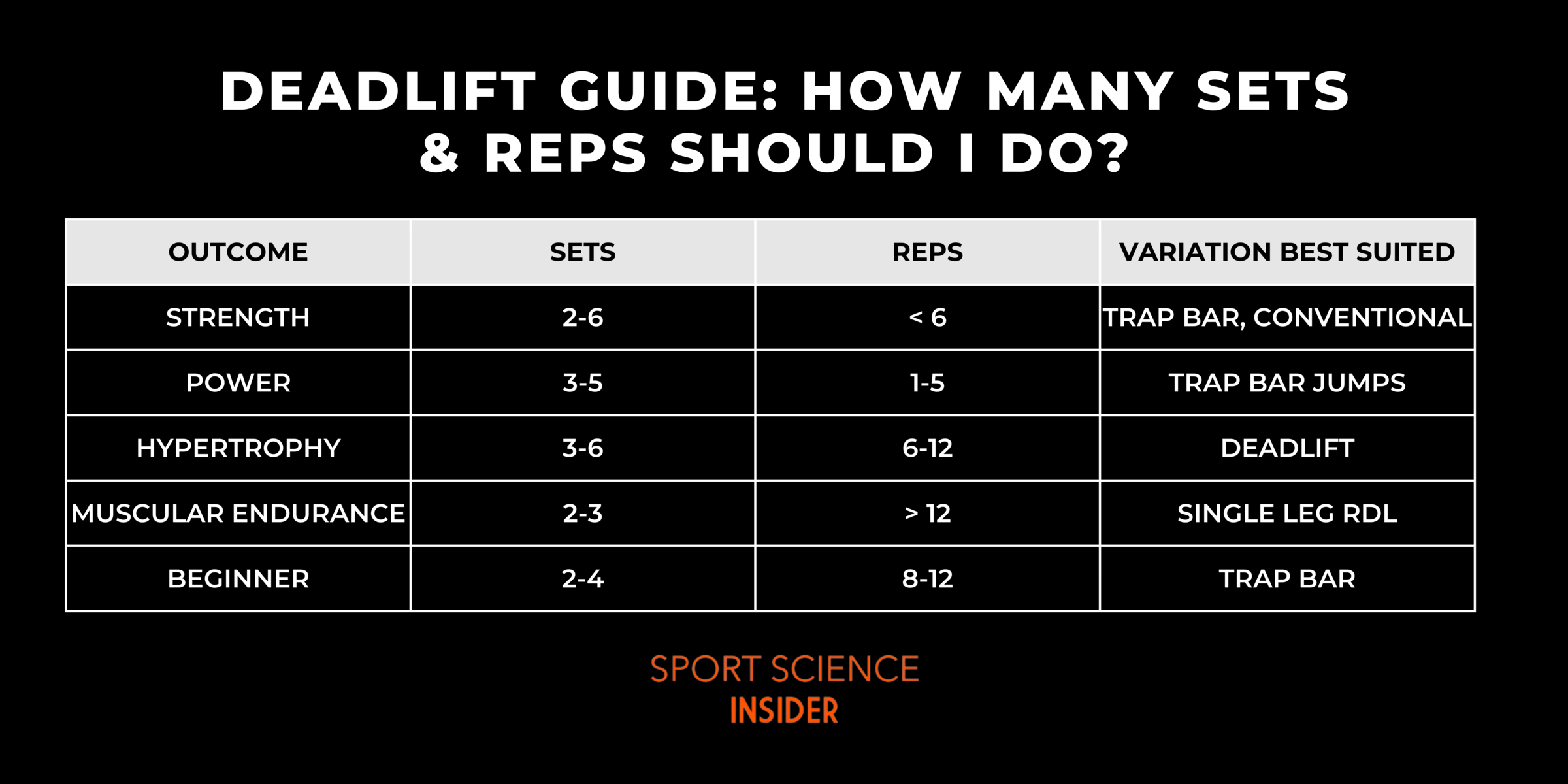Deadlifts are a valuable exercise for any athlete, but a common question athletes, coaches and students often wonder is how many sets and reps they should do. The answer to that question is that it depends, it depends on your training goal and your training experience.
This article will help you to understand the principles behind sets and reps and provide guidance on selecting the right deadlift variation, sets and reps to meet your training outcome.
General Principles of Sets x Reps
There are many factors that go into designing a strength and conditioning programme – the athletes sport, training history, testing results and time of the season often determines our training outcome. It is this training outcome that drives what sets and reps we select, along with the appropriate exercise and load.
Now that we’ve established your training goal will determine your sets and reps, let’s look at general sets x reps guidelines for typical training outcomes, including muscular strength, endurance, hypertrophy and power:

Sets x Reps assignment based on the training outcome (National Strength & Conditioning Association)
It’s important to recognise that these are general guidelines, keep in mind that:
- It isn’t as black and white as the table makes out, training effects are blended across the sets / reps, but those guidelines emphasise that outcome.
- Everyone’s body will respond and adapt differently.
Ok, let’s get more specific for each outcome related to deadlifting! Below we’ll cover what deadlift variation is best suited for each training outcome and therefore sets and reps.
Deadlift Sets x Reps for Building Strength
To build strength, we typically focus on lower rep ranges and higher intensity. Here’s some general guidelines for you:
For compound lifts like trap bar deadlifts or conventional deadlifts, aim for 2-6 sets with 6 or less reps whilst lifting above 81% of your one repetition max if you’re aiming to develop maximal strength. Given that this is heavy and hard work, make sure you have 3-5 minutes rest in between sets so that your body can adapt to the stimulus and you can keep the correct technique.
Now, when it comes to accessory variations of deadlifts like single leg deadlifts, things are a bit different. Since you can’t lift as much weight, you will need to increase the reps. Aim for 6-10 repetitions to build strength.
But, before you delve right into these sets and reps ranges, it’s crucial to have excellent technique and a good training base. Make sure you’ve mastered proper form and a good amount of training under your belt before you look to develop your maximal strength.
Deadlift variations suited for building strength:
- Trap Bar Deadlift
- Conventional Deadlift
Why:
The Trap Bar Deadlift and Conventional Deadlift are great tools for building maximal strength. Both variations offer increased stability of the barbell, enabling you to load the bar to elicit the adaptations for maximum strength.
Both lifts are compound lifts, which are ideal for building maximum strength because they engage multiple muscle groups. By involving more muscles, you can lift heavier weights and stimulate more muscle fibers, leading to greater strength gains.
Deadlift Sets x Reps for Muscular Endurance
If you’re looking to improve your muscular endurance (or robustness) with deadlifts, we’ll switch up the sets and reps to focus on that goal. Here are some handy guidelines to help you out:
Aim for 2-3 sets with 12 or more repetitions whilst lifting moderate weight, and gradually increase the number reps over time. This higher rep range will ensure your muscles endure sustained repeated efforts to help improve your muscular endurance.
This type of work is pretty fatiguing, so make sure you keep up the correct technique.
Deadlift variations suited for building muscular strength (or robustness):
- Single Leg Deadlift
- Romanian Deadlift
- Single Leg Hip Thrust
Why:
The single leg deadlift and romanian deadlift are great deadlift variations for building robustness around the hamstrings with the suggested sets and reps, this is because the hip hinge movement pattern effectively engages the entire length of the hamstring muscles and will be more tolerable to repeated efforts e.g. when running.
The single leg hip thrust is also a great variation alongside the single leg deadlift, as both require stability on on leg while performing the movement. This will activate the smaller stabalizing muscles around the ankle, knee and pelvis and also work on minimising imbalances between each leg.
Deadlift Sets x Reps for Rate of Force Development (Power)
To develop rate of force development, or power using deadlift variations, we look to keep sets and reps low with moderate load and moving with maximum intent.
Aim for 3-5 sets with 1-5 repetitions with load of approximately 30% of your one repetition max. Unlike strength training, we don’t need to keep increasing the amount of weight we lift – this will actually be detrimental! Instead, there must be an emphasis on quality and speed of movement. If quality or speed drop, then you won’t be improving your power (or rate of force development) so take plenty of rest (2-3mins) and approach each rep with maximum effort.
Deadlift variations suited for rate of force development:
- Trap Bar Jumps
- Trap Bar High Pull
- Kettle Bell Swings
Why:
Trap bar jumps are a popular method across strength and conditioning practitioners as an effective power training tool, as the trap bar puts an athletes in a more natural jumping position whilst being able to produce a large amount of power under some load (typically recommended 10-40% of one repetition max for the majority of athletes).
The trap bar high pull also follows similar principles as to the trap bar jumps as to why it lends itself to being a good power training tool, however it doesn’t require the jumping element which may be better suited for some athletes.
Kettle bell swings force you to move fast, which lends itself to developing power.
Deadlift Sets x Reps for Beginners
I can hear you asking, but what if I’m new to deadlifting? The best place to start is learning the hinge movement pattern, which is the foundation of any deadlift variation. Complete plenty of sets and reps (3 x 8-12) at no or low-moderate weight to allow you plenty of practice to get that excellent technique.
Deadlift variations suited for beginners:
- Stick Single Leg Deadlift
- Trap Bar Deadlift
Why:
We’ve had great success coaching the hip-hinging movement pattern with the stick single leg deadlift and trap bar deadlift variations.
The stick single leg deadlift constrains you’re movement and forces you into a hinge movement pattern. This deadlift variation can be used as a tool to get used to this movement and practice, before progressing onto other variations such as the ‘traditional’ single leg deadlift or Romanian deadlift.
The trap bar deadlift is also a great introductory deadlift exercise that is a compound lift. Out of all of the compound deadlift exercises, this is relatively easier to learn and maintain the correct position, meaning athletes can hit the ground running to load it within the first few sessions that they learn this exercise. This is because of the set up position (i.e. hands at side of body, centre of gravity in line with the feet, upright posture), which puts you in an advantageous position to maintain the correct technique
—-
Quick definitions:
Load = This is the amount of weight lifted, commonly described as a percentage of a 1 repetition max (1RM)
Repetitions (Reps) = The number of times to perform an exercise within a set.
Sets = A group of consecutive repetitions of a particular exercise.
Relationship between load & repetitions: the number of repetitions will depend on how much weight you’re lifting: the heavier the load, the lower the repetitions and vice versa.
—-
Summary
First things first, make sure you’ve got excellent technique. If you’re new to deadlifting, complete plenty of repetitions to practice getting that excellent technique. Once you’ve done that and have a good training base, we can then think about adapting sets and reps to meet your training outcome. The general principles are:
- Low reps and high load to build strength
- Low reps and move fast to develop power
- High reps to develop muscular endurance
- Moderate to high reps to increase hypertrophy.
Certain deadlift variations will be better suited than others to the sets and reps to meet your training outcome. Check out our article on deadlift variations to learn more.
Happy deadlifting!
References
NSCA (2012) – Basics of Strength and Conditioning Manual
Emily, co-founder of Sport Science Insider, graduated from the University of Leeds in 2020 and went on to become an accredited S&C coach with the UKSCA in 2022. A former athlete herself, Emily has since gone on to deliver S&C coaching for the Southern Academy of Sport, GB Rowing, GB Taekwondo and works currently as a full-time S&C coach at the University of Leeds.

